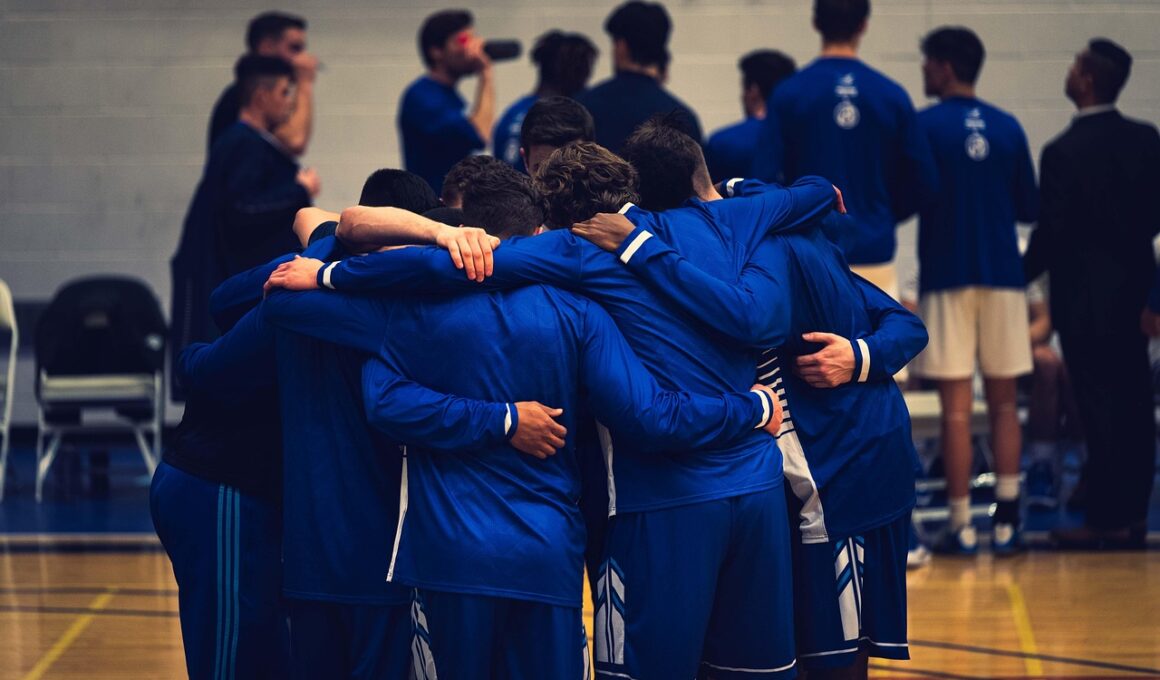How to Organize Effective Basketball Team Building Sessions
Organizing effective basketball team building sessions can significantly enhance team cohesion and performance. Begin by establishing clear objectives for the session, which may involve improving communication or fostering trust among teammates. Assess the team’s needs and strengths, which will help in selecting the appropriate exercises. Gather necessary materials, such as cones, balls, and training equipment, to facilitate the planned activities. Ensure that all participants are aware of the session’s goals through encouraging communication and clarity. During the session, create a supportive environment where each player feels valued and encouraged to participate. Taking the time to explain the importance of each exercise can also motivate team members. Consider incorporating icebreaker games at the start to ease tension and promote bonding. For best results, try to balance serious training with fun activities. This balance will prevent burnout and keep spirits high. Lastly, set aside some time at the end for a debriefing, allowing team members to reflect on the experience and share their insights, which leads to continuous improvement and understanding of group dynamics.
One fundamental aspect of effective basketball team building sessions is the selection of suitable exercises. Exercises should cater to various skill levels and encourage inclusion. Activities such as relay races, trust falls, and problem-solving tasks can be both enjoyable and beneficial. These exercises help players develop essential skills while simultaneously fostering rapport. Ensure that participants are grouped in a way that promotes collaboration across different skill levels. This can enhance understanding and respect within the team. Incorporate drills that target specific areas, such as offensive and defensive strategies, to elevate team performance. Utilizing game-like situations for these drills can help in contextualizing the training within a competitive framework. Another critical point is to allow for adequate warm-up and cool-down periods. Not only do these periods prevent injury, but they also provide an opportunity for team members to interact more casually. Engaging in light-hearted games or discussions during warm-ups aids in breaking down barriers. After the session, solicit feedback from players to understand their perspectives on the exercises and overall experience. This feedback loop is invaluable for future sessions, promoting continuous adaptation and improvement.
Incorporating Feedback and Continuous Improvement
Incorporating feedback from previous basketball training sessions will enhance future team-building efforts. After every session, take time to gather input on the exercises and overall atmosphere. Utilizing anonymous surveys or informal discussions can provide insights that may not be expressed publicly. When team members feel their opinions matter, they are more likely to engage positively in future sessions. Analyze the feedback to identify patterns and areas for improvement, such as whether specific drills felt too challenging or if certain exercises did not resonate with players. Adjust the structure of future sessions based on this data, always striving for a balance between skill advancement and team bonding. Regularly revisit the objectives set at the beginning of your team-building initiatives, ensuring that they remain relevant and achievable. As the season progresses, reevaluate these goals and adapt activities accordingly. This flexibility will demonstrate responsiveness to the team’s evolving needs. Additionally, establishing consistent resources, like an online platform or group chat for sharing experiences and highlights from sessions, can further reinforce the sense of community among players.
Another pivotal component of organizing basketball team building sessions involves fostering inclusivity and openness among teammates. Promote an environment where everyone feels comfortable expressing themselves, regardless of their skill level. Creating a team charter can set the tone for an inclusive atmosphere. This charter can outline team expectations, values, and communication norms that everyone agrees to follow. When players feel safe and respected, their motivation and engagement in team exercises will likely increase. Design exercises that allow for diverse participation, accommodating varying skill levels and playing styles. For example, while competitive drills can identify strengths, collaborative exercises ensure every team member contributes. Recognizing individual skills and contributions can help cultivate trust and camaraderie. Pairing experienced players with newer members during exercises promotes mentorship and learning opportunities. In addition, facilitate open discussions about personal goals and aspirations within the team. This helps individuals feel more connected to the group, enhancing their commitment to team initiatives. Ultimately, a focus on inclusivity will lead to stronger bonds and improved performance, reinforcing the essence of team building in basketball training.
Fun and Engaging Activities
Integrating fun activities into basketball team building sessions can transform the training environment, making it more enjoyable and expressive. After implementing routine drills, introduce games that promote teamwork while keeping spirits high. Activities such as obstacle courses that require collaboration, or modified games like ‘Knockout’ can engage players creatively. Establishing a sense of play can relieve tension while motivating players to give their best effort. Consider organizing friendly competitions or challenges that reward teamwork over individual performance. For example, a three-point shooting contest where team members cheer each other on can reinforce unity. Further, employ themes or variations to classic drills, making them more engaging and less predictable. Activities don’t always have to focus on basketball skills; incorporating challenges that require strategy, like scavenger hunts or team puzzles, can build teamwork effectively. Moreover, team bonding can be enhanced if participants envision themselves achieving a fun goal together. Always conclude sessions with reflection moments, where players can share what they enjoyed most and what they learned, reinforcing camaraderie and enhancing the heart of the team-building experience.
Setting clear intentions for each basketball team-building session can significantly enhance their effectiveness. Before commencing a session, communicate the goals clearly to all players. Establishing objectives helps direct focus and aligns everyone with common aspirations. When team members understand the purpose of their participation, they are more likely to engage wholeheartedly in the activities planned. Have an introductory briefing, discussing the desired outcomes, and explain how the drills will foster collective skills. During the exercises, reiterate these goals, reinforcing their importance as the team performs various tasks. Apart from development goals, establishing a fun atmosphere cultivates positive experiences that are crucial for team bonding. Explore different methods for tracking progress, such as using performance metrics relevant to the drills. Visualizing improvements through simple charts or graphics showcases development, creating excitement around the team’s progress. Motivate each member to set personal milestones related to the group’s objectives as well. Encouraging ownership in learning fosters commitment, thus leading to enhanced productivity. Ultimately, focus on both individual and team goals ensures a well-rounded approach, maximizing the potential of basketball team building sessions.
Conclusion and Future Sessions
As you wrap up your basketball team building sessions, emphasize the progress made and discuss the next steps for continuous development. Acknowledgment of the hard work and improvements achieved during sessions fosters a positive environment. Capturing highlights through photos or videos during activities provides wonderful memories that can be shared among team members. This not only promotes bonding but also creates a sense of belonging to the team. Plan subsequent sessions by revisiting the initial goals while integrating player feedback gathered during previous gatherings. Scheduling team-building sessions regularly will keep the enthusiasm alive and enhance overall team dynamics. Consider rotating responsibilities within the team for organizing future sessions, encouraging everyone to contribute. Facilitating the event planning process among players promotes ownership over their team’s growth. Always be open to revising and adapting the structure of activities to ensure experienced and newer players feel equally involved. Lastly, fostering a culture of enthusiasm towards training can prolong the benefits of team building. Stick to a proactive attitude that continuously promotes fun, teamwork, and skill development, ensuring the ultimate basketball experience is both enriching and enjoyable.
In summary, successful basketball team building sessions require careful planning, open communication, and an understanding of the team’s dynamics. Mixing structured exercises with fun, engaging activities helps create balance. Emphasizing inclusivity and respect cultivates a supportive atmosphere, allowing all players an opportunity for growth. The incorporation of continuous feedback creates a system focused on improvement, ensuring that everyone feels heard and valued. Defining clear objectives directs efforts and nurtures commitment. Ultimately, maintaining a joyful spirit enhances each training session’s effectiveness, promoting unity among teammates. A robust team identity built through strategic team-building activities can elevate player performance both on and off the court. Foster bonds within the team that translate into improved communication during games. Clarity in goals and a fun-filled atmosphere are instrumental in shaping future training experiences. Lastly, documenting progress and celebrating achievements reinforces motivation to keep pursuing team success. By following the outlined strategies, coaches and team leaders can cultivate an environment where players thrive, not only as athletes but as a cohesive and unified collective, ready to face challenges together in every basketball season ahead.


